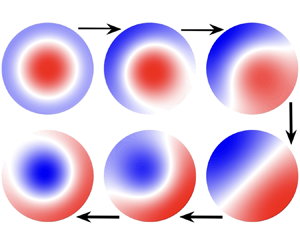Article contents
Resonant triad interactions of gravity waves in cylindrical basins
Published online by Cambridge University Press: 03 July 2023
Abstract

We present the results of a theoretical investigation into the existence, evolution and excitation of resonant triads of nonlinear free-surface gravity waves confined to a cylinder of finite depth. It is well known that resonant triads are impossible for gravity waves in laterally unbounded domains; we demonstrate, however, that horizontal confinement of the fluid may induce resonant triads for particular fluid depths. For any three correlated wave modes arising in a cylinder of arbitrary cross-section, we prove necessary and sufficient conditions for the existence of a depth at which nonlinear resonance may arise, and show that the resultant critical depth is unique. We enumerate the low-frequency triads for circular cylinders, including a new class of resonances between standing and counter-propagating waves, and also briefly discuss annular and rectangular cylinders. Upon deriving the triad amplitude equations for a finite-depth cylinder of arbitrary cross-section, we deduce that the triad evolution is always periodic, and determine parameters controlling the efficiency of energy exchange. In order to excite a particular triad, we explore the influence of external forcing; in this case, the triad evolution may be periodic, quasi-periodic or chaotic. Finally, our results have potential implications on resonant water waves in man-made and natural basins, such as industrial-scale fluid tanks, harbours and bays.
JFM classification
Information
- Type
- JFM Papers
- Information
- Copyright
- © The Author(s), 2023. Published by Cambridge University Press
References
- 5
- Cited by


